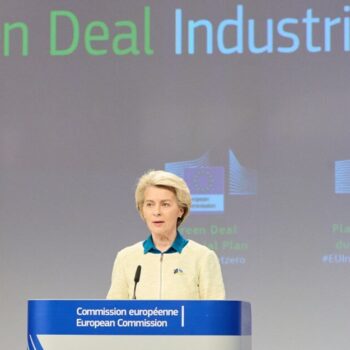On Wednesday, 28 November, the European Commission is expected to release a long-term strategy to curb greenhouse gas emissions. The strategy will assess the feasibility of updating the bloc’s climate ambition for 2050. This is part of the EU's offer to the UN climate conference starting next week as the bloc hopes to inspire others to follow.
Context
A climate strategy? In Europe, climate policy is underpinned by a long-term vision. In turn, European policy triggers action in member states through national caps for emissions and the European carbon market. The European Commission estimated in 2011 that the bloc should cut greenhouse gas emissions by 80% to 95% by 2050 (from a 1990 baseline) to be in line with the expected contribution from developed countries.
Why a new one? Europe already has a roadmap (from 2011), but the context has radically changed:
1. Costs of early climate action have declined dramatically. Looking back at the technical assumptions underpinning the 2011 roadmap, the projected capital cost reductions for 2050 have already been exceeded in 2017 for onshore wind (-20%) and solar PV (-68%).
2. Climate action is increasingly international, leading to new opportunities for cooperation but also new challenges for Europe’s competitiveness. The Paris agreement on climate change requires action by all to limit global warming to well below 2 °C, while pursuing efforts to limit to 1.5 °C. The EU was a first mover but figures by the International Renewable Energy Agency show that Europe’s investment in renewable energy peaked in 2011 and has since massively slowed down, especially in comparison with the rest of the world.
3. Climate goals have strengthened, as the risks of even small amounts of warming become more evident. The International Panel on Climate Change special report on 1.5°C is a dire warning that each fragment of a degree of warming counts to limit the most dangerous consequences of climate change. It illustrates the massive differences of impacts between a world 1.5°C or 2°C warmer.
Why now? The annual UN climate change meeting is happening in Europe from 3-14 December 2018, in Katowice, Poland. In order to remain a champion, the block must show it is implementing the Paris Agreement. The Commission will therefore present the draft of a “long-term low greenhouse gas emission development strategies” required by 2020.
Is the Commission acting alone? The Commission received a clear mandate to draft the strategy. European Heads of States and/or Governments, European Ministers and the European Parliament all called on the European Commission to put forward a proposal for a European climate strategy.
Factors to watch
2050 ambition. The main issue is whether the Commission will be able to demonstrate the feasibility of higher ambition, including a move to net-zero greenhouse gas emissions by 2050. In the public consultation launched earlier this year, the Commission requested feedback on three different objectives: -80%, -95% and net-zero emissions. Since then, several member states, cities and businesses all called for carbon neutrality while some environmental organisations call for net-zero by 2040.
2030 target. The strategy is not likely to address directly the adequacy of the current target for 2030 of at least 40% GHG reductions. This target is a direct product of the 2011 roadmap. It is unclear whether the 2030 target will be a fixed variable, or whether the modelling will show that higher cuts are necessary.
Modelling. The Commission is expected to release a communication and a staff working document including the modelling results. The latter will be of particular importance as civil society organisations have expectations about, for instance, quantifying impacts from climate change or restricting the use of certain solutions such as bioenergy carbon capture and storage.
What’s next
Procedure? This is not a legislative procedure. The outcome will therefore not be law but a political commitment. The strategy document released this week is the first step towards developing a formal long-term low GHG strategy by 2020, to fulfil the EU’s commitment under the Paris Agreement. The Council and the Parliament are not required to discuss the strategy at this stage, but they are expected to do so.
What about the member states? The strategy is very unlikely to require member states to adopt a specific decarbonisation pathway or objective. It may however have some influence. Every member state will produce a national long-term strategy by the end of 2019. Experience shows that European strategies, even non-binding, influence domestic planning.
What about the rest of the economy? Many economic sectors have already prepared their own sectorial long-term roadmap. And many more are expected to do so. For instance, the European power sector is applauding the prospect of an electrification strategy for the energy sector. European heavy industry will soon need to translate the European objective into net-zero goals of their own and consider an extensive toolbox of technological and policy levers to reach them.
Relevant documents
- Net-Zero is feasible – European Climate Foundation, Net Zero by 2050: From whether to how
- Europe must revise its ambition – E3G, The EU’s climate strategy needs a new assessment of ambition
- What are Roadmaps for? E3G, The Politics of Climate Roadmaps: lessons for the EU
- An industry perspective – VUB IES, Industrial Value Chain: A bridge towards a carbon neutral Europe
- Impact of circular economy – Material Economics, The Circular Economy: A powerful force for climate mitigation


